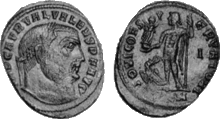
An AE3 coin of Valerius Valens.
In numismatics, the term Constantinian bronzes denotes the series of bronze coins issued in the Roman Empire in the middle of the 4th century. The specific denominations are unclear and debated by historians and numismatists. They are referred to as AE1, AE2, AE3, and AE4, with the former being the largest (near 27 mm) and the latter the smallest (averaging 15 mm) in diameter:
| AE1 | AE2 | AE3 | AE4 |
|---|---|---|---|
| over 25 mm | 21 – 25 mm | 17 – 21 mm | under 17 mm |
In November 2013, the largest hoard of Constantinian bronze coins was discovered in Devon, England. Called the Seaton Down Hoard, it consists of 22,000 coins, mostly Constantinian bronzes.[1]
See also
References
- ↑ "Large Roman coin hoard unearthed". Archived from the original on 2014-11-05. Retrieved 2014-11-05.
This article is issued from Wikipedia. The text is licensed under Creative Commons - Attribution - Sharealike. Additional terms may apply for the media files.